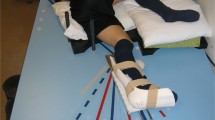Abstract
Oculomotor dysfunctions are hidden causes of invalidity following whiplash injury. Many patients with whiplash injury grade II present oculomotor dysfunctions related to input disturbances of cervical or vestibular afferents. We used static posturography to investigate 40 consecutive patients with whiplash injury grade II and oculomotor dysfunctions. We demonstrated a relation between length and surface of body sway: the surface value (A) was higher than the length value (L) and this led to an open graph of body sway in the statokinesigram. Oculomotor rehabilitation can resolve the impairment of vestibular function but if therapy is delayed or the patient has been wearing an orthopaedic neck collar, more therapeutic sessions are required. In conclusion, without rehabilitation of the oculomotor muscles other therapies are not sufficient to recover the impairment caused by whiplash injury.

Similar content being viewed by others
References
Association Francaise de posturologie (1986) Normes 1985. Association Française de Posturologie (eds), Paris
Barlow D, Freedman W (1980) Cervico-ocular reflex in normal adult. Acta Otolaryngol 89:487–496
Baron JB, Fowler E (1952) Prismatic lenses for vertigo and some experimental background of the role the extrinsic ocular muscles in disequilibrium. Trans Am Acad Ophthal Otolaryngol 56:916–926
Burke JP, Orton HP, Westa J, Strachan IM, Hockey MS, FergusonDG (1992) Whiplash and its effect on the visual system. Arch Clin Exp Ophtalmol 230(4):335–339
Gagey PM, Bizo G, Bonnier L, Gentaz R, Guillaume P, Marucchi C, Villeneuve P (1993) Huit leçons de posturologie. Association Française de posturologie (eds), Paris
Heikkila HV, Wenngren BI (1998) Cervicocephalic kinesthetic sensibility, active range of cervical motion, and oculomotor function in patients with whiplash injury. Arch Phys Med Rehabil 79(9):1089–1094
Hikosaka O, Maeda M (1973) Cervical effects on abducens motorneurons and their interaction with vestibulo-ocular reflex. Exp Brain Res 18:512–530
Hildingsson C, Wenngren BI, Bring G, Toolanen G (1989) Oculomotor problems after cervical spine injury. Acta Orthop Scand 60(5):513–516
Hildingsson C, Wenngren BI, Toolanen G (1993) Eye motility dysfunction after soft-tissue injury of the cervical spine. A controlled, prospective study of 38 patients. Acta Orthop Scand 64:129–132
Hinoki M (1984) Vertigo due to whiplash injury: a neurotological approach. Acta Otolaryngol 419(Suppl):9–29
Holtmann V, Reiman V, Scherer H (1989) Cervico-ocular eye movements in relation to different neck torsion velocities. Acta Otolaryngol 468(Suppl):191–196
Hugonnier R (1970) Traitement orthoptique des hétérophories et de l’insufficiance de convergence. In: Hugonnier R, Hugonnier S (eds) Strabismes, hétérophories-paralysies oculo-motrices. Masson, Paris, pp 624–640
Kobayashi Y, Yagi T, Kamio T (1986) Cervicovestibular interaction in eye movements. Auris Nasus Larynx 13:87–95
Macnab I (1971) The whiplash syndrome. Orthop Clin North Am 2:389–403
Magnusson AK, Tham R (2003) Vestibulo-oculomotor behaviour in rats following a transient unilateral vestibular loss induced by lidocaine. Neuroscience 120:1105–1114
Nagakawa H, Ohashi N, Watanabe Y, Mizukoshi K (1993) The contribution of proprioception to postural control in normal subjects (Stockh). Acta Otolaryngol 504(Suppl):S112–S116
Norris SH, Watt I (1983) The prognosis of neck injuries resulting from rear end vehicle collisions. J Bone Joint Surg Br 65:608–611
Schubert MC, Minor LB (2004) Vestibulo-ocular physiology underlying vestibular hypofunction. Phys Ther 84(4):373–378
Spitzer WO, Skovron ML, Salmi LR, Cassidy JD, Duranceau J, Suissa S, Zeiss E (1995) Scientific monograph of the quebec task force on whiplash-association disorders: redefining “whiplash” and its management. Spine 20:S1–S73
Wenngren BI, Toolanen G, Hildingsson C (1998) Oculomotor dysfunction in rheumatoid patients with upper cervical dislocation. Acta Otolaryngol 118(5):609–612
Yasuda T, Nakagawa T, Inoue H, Iwamoto M, Inokuchi A (1999) The role of the labyrinth, proprioception and plantar mechanosensors in the maintenance of an upright posture. Eur Arch Otorhinolaryngol 256(Suppl 1):S27–S32
Author information
Authors and Affiliations
Corresponding author
Rights and permissions
About this article
Cite this article
Storaci, R., Manelli, A., Schiavone, N. et al. Whiplash injury and oculomotor dysfunctions: clinical–posturographic correlations. Eur Spine J 15, 1811–1816 (2006). https://doi.org/10.1007/s00586-006-0085-0
Received:
Revised:
Accepted:
Published:
Issue Date:
DOI: https://doi.org/10.1007/s00586-006-0085-0




